

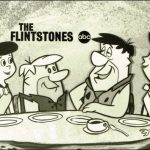
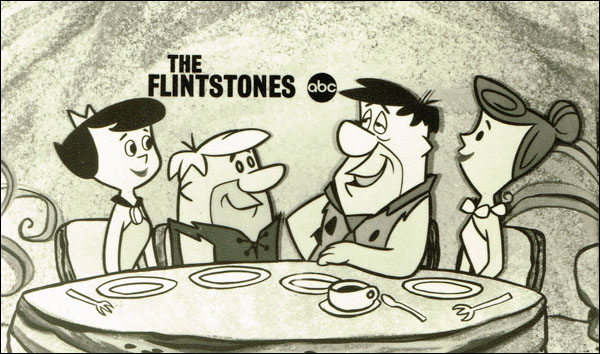
Pre-history made television history on September 30, 1960. It’s on that date that The Flintstones debuted on ABC. Hanna-Barbera’s series would be a groundbreaking as the very first prime-time animated situation comedy, but would also become an iconic, pop-culture landmark that still resonates for many today.
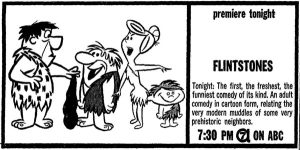 The famous Stone Age family, Fred, Wilma, Pebbles, and Dino, along with their neighbors, the Rubbles, Barney, Betty, and Bamm-Bamm, are celebrating their sixty-fifth anniversary this fall.
The famous Stone Age family, Fred, Wilma, Pebbles, and Dino, along with their neighbors, the Rubbles, Barney, Betty, and Bamm-Bamm, are celebrating their sixty-fifth anniversary this fall.
“In my opinion, a significant part of its appeal lies in its simplicity,” said Noah Bell, writer, animation historian, and creator of the Hanna-Barbera blog, The Exposure Sheet. “The Flintstones is a simple family sitcom, but with a prehistoric setting. The stories were ones that anyone could relate to, regardless of their backgrounds. There’s also a simple appeal to seeing things we all use in our lives but depicted during the age of dinosaurs. But I think what really made The Flintstones special is that its prehistoric family felt like…well, a family.”
The Flintstones were born from a time when William Hanna and Joseph Barbera, after years at MGM, bringing audiences award-winning Tom and Jerry short subjects, were transitioning to television. Following the success of shows such as the Emmy-winning Huckleberry Hound and Quick Draw McGraw, Hanna-Barbera sought a way to reach a new audience with their work.
“One of the people who encouraged them to create a sitcom for prime time was George H. Mitchell, a marketing executive with Screen Gems, the company that partnered with Hanna-Barbera,” explained Greg Ehrbar, author of Hanna-Barbera, The Recorded History, and host of the podcast, The Funtastic World of Hanna and Barbera.
“They got into prime time for the same reason that Walt Disney entered feature-length animation. Short cartoons were fine, but sitcoms would place Hanna-Barbera into the most important place in television and help sustain them as a company.”
Once the idea for an animated sitcom surfaced, several different settings were explored, including pilgrims and ancient Romans (the latter would eventually make it to the screen in Hanna-Barbera’s 70s Saturday morning NBC series The Roman Holidays).
 Eventually, all agreed on a prehistoric setting, originally entitled The Gladstones, then The Flagstones, that changed to Flintstones when it was thought it might be confused with the last name of the characters in Mort Walker’s Hi and Lois comic strip, which was Flagston.
Eventually, all agreed on a prehistoric setting, originally entitled The Gladstones, then The Flagstones, that changed to Flintstones when it was thought it might be confused with the last name of the characters in Mort Walker’s Hi and Lois comic strip, which was Flagston.
Once it debuted, The Flintstones was a tremendous hit with audiences, and by the third season, Wilma gave birth to Pebbles in an episode entitled “The Blessed Event” (also known as “Dress Rehearsal”).
In their book, It’s Saturday Morning! Celebrating the Golden Era of Cartoons, authors Joe Garner and Michael Ashley share a story about “The Blessed Event” and the popularity of The Flintstones at the time:
“Barbera revealed he originally intended the child to be a boy until he spoke with the Ideal Toy Company. ‘One day, I received a call from the guy in charge of Flintstones merchandising. He said, ‘Hey, I hear you’re having a baby on the show.’ I said, ‘Yeah.’ He said, ‘Is it a boy or a girl?’ ‘What else, a boy. A chip off the old rock.’ He says, ‘That’s too bad. If it was a girl, we could have made a hell of a deal.’ I said, ‘It’s a girl.’ They sold three million Pebbles dolls within the first couple of months.”
“To this day, it is still usually more profitable to develop female characters that translate into dolls, accessories, and clothing,” Greg pointed out. “Films tend to be made at a deficit, but if they sell merchandise, they are considered viable franchises.”
“The Blessed Event” turned out to be “event television,” with millions tuning in when it aired on February 22, 1963.
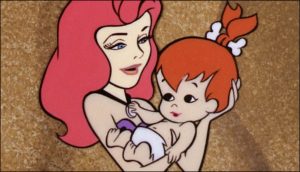
Ann Margrock and Pebbles
The Flintstones gave us so many episodes that continue to be memorable, such as “Son of Rockzilla,” where Fred gets a job donning a costume to play a monster in a B-movie, “The Gruesomes,” where Addams Family-like neighbors move next door to Fred and Wilma and “Christmas Flintstone,” where Fred fills in for Santa Claus on Christmas Eve.
There were also the creative ways that contemporary appliances, technology, and vehicles were brought to life in The Flintstones, which became a hallmark of the show. From mastodon vacuums to Pterodactyl airplanes and swordfish knives – “Hey, it’s a living!”
Bringing all of this to life was a stellar cast of veteran voice actors: Alan Reed as Fred, Jean Vander Pyl as Wilma, Mel Blanc as Barney, as well as Dino, and Bea Benaderet as Betty.
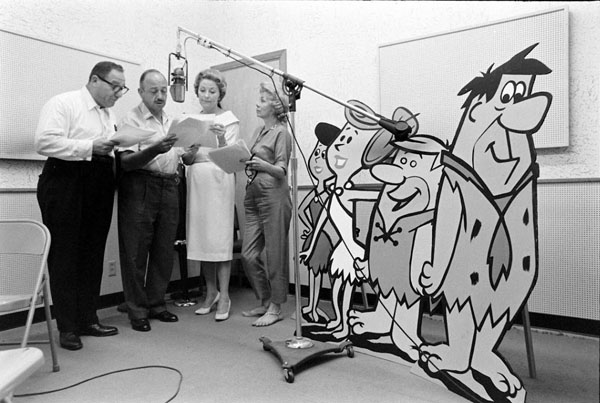
Pictured left to right: Alan Reed as Fred, Mel Blanc as Barney, Jean Vander Pyl as Wilma, and Bea Benaderet as Betty.
In fact, it was Reed who came up with “Yabba-Dabba-Doo!” for Fred and, in turn, created one of pop culture’s most memorable catch phrases. “Alan Reed also insisted that the characters speak with only a slight affectation for their characters, not as broad as commonly done in cartoons, with the exception of features and UPA shorts,” Greg added. “This technique is still used on most prime-time animated series.”
Like “Yabba-Dabba-Doo,” the Flintstones theme song has been seared into our collective minds, thanks to a collaboration between Hanna-Barbera and their longtime music partner, Hoyt Curtin, the genius behind the songs and scores in many of their popular shows.
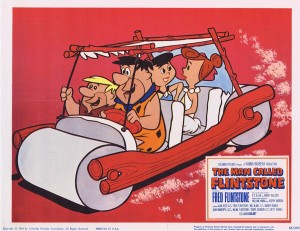 Interestingly, an instrumental theme song entitled “Rise and Shine” was used in the first two seasons of the series, with “Meet the Flintstones” introduced on a Golden LP record and added within season three, securing its place in TV music history.
Interestingly, an instrumental theme song entitled “Rise and Shine” was used in the first two seasons of the series, with “Meet the Flintstones” introduced on a Golden LP record and added within season three, securing its place in TV music history.
The Flintstones ended their prime time run on April 1, 1966. There was also a full-length animated feature in ’66, The Man Called Flintstone, which featured the characters in an international spy story. Reruns continued for decades after (and still do on MeTV Toons), and there would be plenty of other iterations through the years.
Some include The Pebbles and Bamm-Bamm Show, which debuted as a sequel of sorts in 1971, with the Flintstone and Rubble kids now teenagers. The New Fred and Barney Show, which premiered in 1979, featured more traditional Flintstone episodes with added fantastical elements. There was the offbeat Fred and Barney Meet the Thing and Fred and Barney Meet the Schmoo (both 1979), and The Flintstone Kids in 1986, a prequel series that featured the characters as children (a popular Saturday morning trend of the time).

From the collection of David Nimitz
Since debuting in 1960, The Flintstones have not only become some of the major stars in Hanna-Barbera’s history, but they have also become a part of the television and movie landscape that has been handed down from generation to generation. And it doesn’t stop with TV. The characters have been associated with two national brands for many years: Flintstone Vitamins and Pebbles cereal.
“It’s a fact that shows like The Simpsons and Family Guy would never have existed if it weren’t for their prehistoric predecessor, The Flintstones,” Noah said. “The show continues to play on TV today all over the world. It has also become a major franchise, much like many of its contemporaries, resulting in a plethora of spin-offs, movies, merchandise, and more.”
“The Flintstones was a milestone in animated storytelling,” said Greg. “Hanna-Barbera innovated a form of entertainment that factually influences all animated sitcoms. Many within today’s animation industry willingly cite The Flintstones as the ‘touchstone,’ so to speak.”
Sixty-five years later, The Flintstones continue to ‘rock’ on.